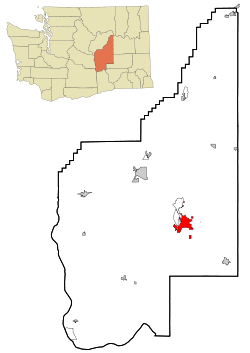Moses Lake, Washington
| Moses Lake, Washington | |
|---|---|
| City | |

Aerial view of Moses Lake & Potholes Reservoir
|
|
 Grant County, Washington |
|
| Coordinates: 47°7′16″N 119°17′18″W / 47.12111°N 119.28833°WCoordinates: 47°7′16″N 119°17′18″W / 47.12111°N 119.28833°W | |
| Country | United States |
| State | Washington |
| County | Grant |
| Area | |
| • City | 18.75 sq mi (48.56 km2) |
| • Land | 15.75 sq mi (40.79 km2) |
| • Water | 3.00 sq mi (7.77 km2) |
| Elevation | 1,070 ft (326 m) |
| Population (2010) | |
| • City | 20,366 |
| • Estimate (2015) | 22,082 |
| • Density | 1,293.1/sq mi (499.3/km2) |
| • Metro | 93,147 |
| Time zone | Pacific (PST) (UTC-8) |
| • Summer (DST) | PDT (UTC-7) |
| ZIP code | 98837 |
| Area code(s) | 509 |
| FIPS code | 53-47245 |
| GNIS feature ID | 1512481 |
| Website | www.cityofml.com |
Moses Lake is a city in Grant County, Washington, United States. The population was 20,366 as of the 2010 census. Moses Lake is the largest city in Grant County.
Moses Lake, on which the city lies, is made up of three main arms over 18 miles (29 km) long and up to one mile (1.6 km) wide. It is the largest natural body of fresh water in Grant County and has over 120 miles (190 km) of shoreline covering 6,500 acres (2,600 ha). Before it was dammed in the early 1900s and then incorporated into the Columbia Basin Project, Moses Lake was a smaller, salty, shallow lake. One of its early names was "Salt Lake". To the south of the town is the Potholes Reservoir and the Columbia National Wildlife Refuge that has a number of seep lakes and vast amounts of migratory birds and other fauna natural to the area.
Before the construction of Grand Coulee Dam on the Columbia River in 1941 and Larson Air Base in 1942 the area was largely barren. Native Americans knew the area as Houaph, which meant willow. Chief Moses was leader of the Sinkiuse tribe from 1859 to 1899, and was forced to negotiate with white settlers who began to settle in the area in the 1880s. Under pressure from the government, Chief Moses traded the Columbia Basin land for a reservation that stretched from Lake Chelan north to the Canada–US border. The government later traded again for what is now the Colville Indian Reservation.
The new settlers named the lake in honor of the chief. The city was originally named Neppel, after a town in Germany where one of the original settlers had lived. The first settlers established fisheries and farms — some of the first exported items were carp, jackrabbits and fruit — but irrigation attempts failed and settlers left at about the same rate as they came. When the town was incorporated and renamed Moses Lake in 1938, the population was estimated at 301 people.
...
Wikipedia
